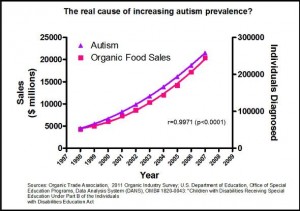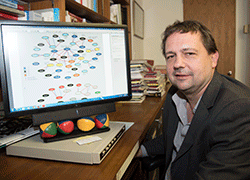Sep
30
2014
 It is no longer news that Dr. Oz has long ago abandoned any pretense to scientific rigor and is simply another scaremongering hawker of snake oil and nonsense. Still, it’s hard not to marvel when he sinks to a new low.
It is no longer news that Dr. Oz has long ago abandoned any pretense to scientific rigor and is simply another scaremongering hawker of snake oil and nonsense. Still, it’s hard not to marvel when he sinks to a new low.
On a recent show Oz’s target was genetically modified organisms (GMO). This is not new for Oz, he has hosted anti-GMO activists in the past, warning his audience about non-existent health risks.
This time around Oz and his guest are claiming that pesticides used with certain GMO varieties may cause autism. Why is it always autism? It’s likely at least partly due to the fact that awareness of autism has been increasing in the last 2 decades, creating the false impression that autism itself is increasing. This leads to numerous false correlations (most famously with vaccines) and the assumption of cause and effect (often to support a preexisting bias). As you can see from the graph, however, the rise in autism diagnoses tightly correlates with increased organic food sales – but I guess you have to cherry pick the correlation you want.
The narrative that Oz spun for his audience was this: GMO is tied to pesticide use. Those pesticides are hazardous to your health, and specifically might cause autism. Organic food is pesticide free, and going organic can actually cure autism.
Every link in that chain of argument is misleading or patently wrong.
Continue Reading »
Sep
29
2014
 A new study looks at how our brains respond to images of celebrities made ambiguous by morphing two images into one, such as the combination of Halle Berry and Angelina Jolie shown here. The question is – will our brains fire in a way that represents the details of the picture, or will they fire based upon how we perceive the picture?
A new study looks at how our brains respond to images of celebrities made ambiguous by morphing two images into one, such as the combination of Halle Berry and Angelina Jolie shown here. The question is – will our brains fire in a way that represents the details of the picture, or will they fire based upon how we perceive the picture?
The researchers were able to study subjects who had small electrodes placed on the surface of their brains for clinical purposes. Such electrodes are capable of detecting the firing of a single brain neuron. They showed the subjects pictures of two celebrities to see how their brains responded. Typically a single neuron, which encodes the memory of that particular celebrity, would fire. They then showed them a morphed picture and asked them to identify the celebrity.
When subjects recognized Halle Berry, for example, the single neuron that previously fired when viewing Halle Berry also fired.
This is an interesting, but not unexpected, result. How does this fit into our understanding of brain function?
Continue Reading »
Sep
26
2014
The Food and Drug Administration (FDA) is tasked with ensuring quality and transparency in the foods and drugs that are sold to consumers. This is a daunting task, and by all accounts the FDA is commonly understaffed, without the resources to thoroughly do its job. Further, politics often hamstrings the agency, so they don’t have the actual authority to do their job.
The most egregious example is the Dietary Supplement Health and Education Act of 1994 (DSHEA). This law (courtesy of Hatch and Harkin) effectively removed “supplements” out of the control of the FDA, and broadly defined supplements to include herbal drugs and other products that are not actually dietary supplements.
Essentially DSHEA created two categories of consumable health products. Drugs, by definition, are any products for which specific disease claims are being made. If you say your pill or ointment treats diabetes, then it’s a drug, because diabetes is a disease. A supplement, by definition, makes no claims to cure or treat a disease, but is allowed to make “structure function” claims. This is a giant loop hole manufactured by DSHEA and wrapped as a present for the supplement industry, at the expense of consumers.
Continue Reading »
Sep
25
2014
On December 14, 2012, a disturbed shooter killed 20 children and 6 adult staff at the Sandy Hook Elementary School. This was a horrific event, and the community is still recovering.
Almost immediately after the shooting, and continuing to this day, conspiracy theorists have been shoe-horning this tragic event into their preferred narrative, calling the event a “false flag” operation. In other words, they believe that no children were killed on that day. The entire event was staged by the powers that be as a pretext to take away the guns of law-abiding citizens.
The claim is absurd on its face, but does provide an interesting window into how people can come to believe something that seems so “bat shit crazy.” It provides a lesson into the iron grip that a compelling narrative can have on someone’s mind.
The preferred narrative of the conspiracy theorist is that you cannot believe anything anyone in authority says. The government lies and only seeks to oppress us, so if the government says something it cannot be true. Anyone who believes the government is hopelessly naive.
So if “corporate media” is saying children were killed at Sandy Hook it must not be true, no matter how implausible the alternative might be.
Continue Reading »
Sep
23
2014
I, like most people, like to categorize things. It helps me keep my mental space organized and tidy. A good system of categorization is also like a framework on which I can hang specific facts and details. Categories are most useful when they reflect underlying reality, rather than superficial or arbitrary features. Categories are therefore often at the nexus of facts and theory in science – they can organize the facts in a way that reflects the underlying theory.
You have to be cautious, however. Reality often does not cleave in clean straight lines. There are likely to be exceptions to any rules one devises for defining specific categories. Groups tend to be fuzzy around the edges. While categories can be a useful tool for organizing ideas, they can also become a mental prison or straightjacket.
Is Pluto a planet? It depends on how you define planet, and why you would define planet in any particular way. Is there a difference between planets, dwarf planets, and planetoids? Or do these objects exist along a spectrum and scientists are simply drawing arbitrary lines for convenience? Is schizophrenia one disease or a group of diseases, how do we categorize the subtypes, and do they reflect real underlying differences in cause? Are such labels helping or hindering research?
Continue Reading »
Sep
22
2014
 A recent New Yorker article by Michael Specter does an excellent job of putting the activism of anti-GMO campaigner, Vandana Shiva, into perspective. Shiva has since written a very critical response to Specter, and The New Yorker has responded to Shiva. The exchange is very enlightening.
A recent New Yorker article by Michael Specter does an excellent job of putting the activism of anti-GMO campaigner, Vandana Shiva, into perspective. Shiva has since written a very critical response to Specter, and The New Yorker has responded to Shiva. The exchange is very enlightening.
Shiva is a dedicated anti-GMO activist, perhaps the most widely known and successful in the world. Specter paints a picture of Shiva as more than an ideologue – a “demagogue” who has created a dramatic narrative that is meant to frighten the public about GMOs, but has little to do with reality. For Shiva, her anti-GMO stance is part of a broader economic and social ideology. In her vision of the world, local farmers would feed the world with organic farming, without fertilizer or corporate involvement. The actual science about GMOs seems to be irrelevant to her narrative.
Specter illustrates several example. There are definitely religious undertones to her activism. For example, Specter quotes her from a speech earlier this year:
“G.M.O. stands for ‘God, Move Over,’ we are the creators now,”
Continue Reading »
Sep
19
2014
 This Week Louisiana Governor Bobby Jindal gave an excellent lesson on how to be a science denier. Unfortunately, this was not a faux demonstration, he was sincere.
This Week Louisiana Governor Bobby Jindal gave an excellent lesson on how to be a science denier. Unfortunately, this was not a faux demonstration, he was sincere.
If you recall, in 2012, Jindal advised Republicans to stop being “the stupid party.” This was a provocative statement. I wondered at the time if this signaled a shift in the party away from having anti-science on their platform. Had party insiders finally realized they can’t hang their political future on denying undeniable science, that they need to embrace reality and stop fighting against it?
Alas, it seems that a more cynical interpretation is closer to the truth – that Jindal was simply worried about damage to the Republican brand caused by Republicans saying “offensive, bizarre” comments, but not by the substance of their positions on scientific issues.
At a recent breakfast hosted by the Christian Science Monitor, Jindal was introduced as a Brown graduate at the age of 20 with a biology major, then a Rhodes Scholar at Oxford, and having a 2 year stint as the president of the University of Louisiana, along with many other accomplishments. So he is a scholar and, to some extent, an academic, with advanced study in biology specifically.
During the breakfast, which included journalists, Jindal was asked about global warming. In response to this issue, Jindal performed a very deft dance. He said, “Let the scientists decide,” referring to whether or not global warming is happening. This, of course, is a clever denialist tactic. The hidden premise here is that the scientists have not already spoken with a unified and loud voice. They have decided – it is clear that human activity is increasing greenhouse gases in the atmosphere and warming the climate.
Continue Reading »
Sep
18
2014
 A new study published in Nature is getting a lot of press, and it seems making a lot of people worried. The Nature News article discussing the study has the headline: Sugar substitutes linked to obesity. I think this headline is misleading. Here’s a breakdown of what the study does and does not tell us.
A new study published in Nature is getting a lot of press, and it seems making a lot of people worried. The Nature News article discussing the study has the headline: Sugar substitutes linked to obesity. I think this headline is misleading. Here’s a breakdown of what the study does and does not tell us.
The study’s title is more descriptive, as one might expect: Artificial sweeteners induce glucose intolerance by altering the gut microbiota. The authors (A team led by Eran Elinav of the Weizmann Institute of Science in Rehovot, Israel) studied three noncaloric artificial sweeteners (NAS), saccharin, sucralose, and aspartame. They fed mice that either had a microbiota (bacteria colonizing their gastrointestinal system) or those that were germ free either NAS or control food without NAS. After 11 weeks the mice fed NAS showed signs of glucose intolerance – their blood sugar rose more when challenged with a dose of sugar.
They also found that mice treated with antibiotics did not have this response. Further, they performed fecal transplants from NAS treated mice to germ-free mice and found that the glucose intolerance transferred with the bacteria. They also cultured bacteria with NAS and transplanted that into mice, who then became glucose intolerant.
Continue Reading »
Sep
16
2014
 A new study sheds further light on the genetic basis of the group of psychiatric disorders known collectively as schizophrenia. Further, the study (actually a collection of four studies) takes a new approach that might prove generally useful in associating genetic variation with disease risk, even beyond psychiatry.
A new study sheds further light on the genetic basis of the group of psychiatric disorders known collectively as schizophrenia. Further, the study (actually a collection of four studies) takes a new approach that might prove generally useful in associating genetic variation with disease risk, even beyond psychiatry.
Schizophrenia
In popular culture the term “schizophrenic” is often used to mean split personality or multiple personality, but this has never been the actual definition of the term. I’m not sure what the origin of this misconception is. The word “schizophrenia” does mean “split mind” but refers to mental illness characterized by disordered or delusional thinking. The “split” is between reality and mental function.
For at least several decades it has been clear that schizophrenia is not one discrete disorder, but rather it is a set of similar disorders. Symptoms include hallucinations, delusions (persistent false beliefs that do not have a cultural cause), impaired reality testing, bizarre thoughts and behaviors, often but not always paranoid in nature, a disconnection between thoughts and emotions, and lack of motivation or activity.
Part of the challenge of studying schizophrenia is that it is a clinically defined set of disorders, meaning that the category is based upon the signs and symptoms displayed, not any knowledge about underlying cause or biology. The brain, as you might suspect, is an incredibly complex organ with many interacting parts, and so there is likely to be a complex relationship between the underlying mechanisms of schizophrenia and the clinical manifestations.
Continue Reading »
Sep
15
2014
 NeurologicaBlog is very meta. I like to not only communicate science, but explore how best to communicate science, including thinking about how to communicate the need to think about thinking. (Cue the endless meta-regression.)
NeurologicaBlog is very meta. I like to not only communicate science, but explore how best to communicate science, including thinking about how to communicate the need to think about thinking. (Cue the endless meta-regression.)
For example, there is often much to criticize about how science news is reported in the general media. Part of the problem is that science mostly advances by accumulating baby steps. Baby steps, however, don’t always make for compelling headlines, and so every advance becomes a “breakthrough,” every mystery has scientists “baffled,” and every study may some day lead to the cure for cancer, rid us of the common cold, or produce a piece of technology similar to that found in popular science fiction.
Part of the challenge of being a skeptical science communicator is to convey simultaneously the deserved awe of cool science, including the potential implications of genuine advances, while also discussing the need for caution in interpreting results, and essentially throwing a wet blanket on premature hype. It can be a delicate balancing act.
I had all this in mind when I approached the main topic of today’s post – a rather exciting and anticipated advance in stem-cell technology. Japanese researchers have created a sheet of retinal epithelial cells from a patient’s own skin cells. First they had to induce pulripotency on the skin cells, which essentially turns them into stem cells (iPS cells). Then they had to coax these created stem cells into becoming the desired cell type which in this case is retinal epithelial cells.
Continue Reading »
 It is no longer news that Dr. Oz has long ago abandoned any pretense to scientific rigor and is simply another scaremongering hawker of snake oil and nonsense. Still, it’s hard not to marvel when he sinks to a new low.
It is no longer news that Dr. Oz has long ago abandoned any pretense to scientific rigor and is simply another scaremongering hawker of snake oil and nonsense. Still, it’s hard not to marvel when he sinks to a new low.











